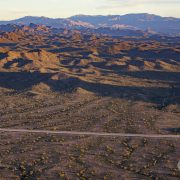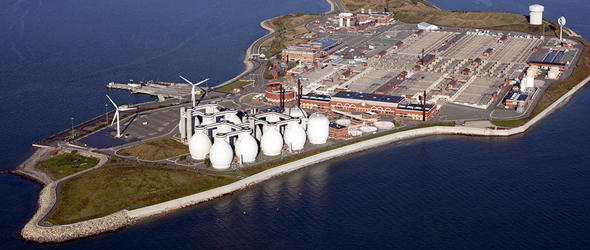Economics and Water Concerns Alter the Solar Landscape in the US West
The falling price of photovoltaic panels and public concerns about aquifers and rivers in the western United States are boosting solar energy technologies that save water.
In December, the U.S. Department of the Interior (DOI) approved a 300-megawatt (MW) solar energy project on public land in southwestern Arizona on condition that the developer changes the plant’s design from concentrated solar thermal collectors — which use mirrors and fluids to generate steam to run a turbine — to photovoltaic (PV) panels.
The PV technology will cut down the plant’s water consumption by almost 99 percent. Instead of pumping 3.7 million cubic meters (977 million gallons) per year from the nearby Rainbow Valley aquifer, the facility will use a mere 40,705 cubic meters (10.7 million gallons), primarily for washing the panels.
Each drop conserved is important in the arid Southwest, where the water from most river basins is fully allocated and where climate models predict an even drier future.
The Sonoran Solar Energy Project, as the facility in southwestern Arizona is known, is among a growing number of solar energy projects across the deserts of the American West to make design changes that use less water. As the federal government pushes solar power production, developers both on public and private lands are increasingly switching from wet cooling to dry cooling — like the proposed Quartzsite Solar Energy Project in Arizona — or swapping mirrors for PV panels, which are getting cheaper each year.
Government Targets, Public Pressure, Market Forces
The solar boom in the United States was kick-started by a provision in the Energy Policy Act of 2005, which required the DOI to approve 10,000 MW of non-hydroelectric renewable energy projects by 2015. Then in 2009, the Obama administration called for rapid development of solar and wind power on public lands, and set a target of getting 25 percent of the nation’s electricity from renewable sources by 2025.
Yet in the midst of this development, concerned citizens have pushed regulators to consider solar technologies that save water. During the permitting process for the Sonoran project, the DOI requested less water-intensive PV panels after several residents in the area worried that water withdrawals for solar power generation would draw down the shallow aquifer that the community is using for drinking water.
“Given feedback from stakeholders, the decision is one that we support,” said Steve Stengel, a press officer for NextEra Energy Resources, the parent company of the Sonoran project developer.
Though the DOI generally does not have jurisdiction over water rights, it does assess the total environmental consequences of resource use. As part of the evaluation process, the department can require an alternate technology if a project is estimated to use too much water.
“There haven’t been [federal] regulatory changes,” said Arreola. “But we have seen changes in the developers.”
Those changes, Arreola told Circle of Blue, are being driven by industry economics. The falling price of PV panels has in recent years prompted more and more developers to choose this technology instead of the more established solar thermal systems. According to GTM Research, the price of silicon panels fell by half in 2011, to $0.90 per watt, and will drop even more.
The downward price pressure caused Solar Trust of America, which is developing the world’s largest solar project — a 1,000 MW facility in the Mojave Desert near Blythe, Calif. — to alter its plans.
In August, Solar Trust decided to switch the Blythe plant from a solar thermal design with parabolic troughs to PV panels. The company is “deploying the right technology at the right time,” Uwe Schmidt, the chairman and chief executive, said in a statement.
The trend is evident across the U.S. solar industry. According to data from the Solar Energy Industries Association, a trade group, some 82 percent of projects under development plan to use PV technology. By contrast, just 61 percent of projects already in operation do so.
The fall in solar panel prices comes as a group of U.S. manufacturers have accused the Chinese government of unfairly subsidizing the Chinese solar industry and flooding the American market with artificially cheap goods. The U.S. Commerce Department is investigating whether tariffs should be imposed on solar panel imports from China.
Meanwhile, the U.S. Department of the Interior is conducting a broad environmental review of solar development on public lands in six western states. The review aims to amend the department’s resource management plans so that solar projects are directed to the most suitable parcels of land.
Water concerns, among other issues, have already prompted the DOI to cut the number of proposed “solar energy zones” from 24 to 17. Officials from Lincoln County, Nev., for instance, have requested that only PV technology be allowed in a neighboring zone because of worries about groundwater withdrawals. The DOI eventually withdrew the land from consideration.
Until the environmental review is complete, all public lands administered by the Bureau of Land Management (BLM) are open for solar development. In the last two years, no less than 16 solar projects have been approved for BLM land.
Solar development on private lands can also result in a net gain in water if it displaces irrigated agriculture, as has happened in many western states.
View Solar on BLM Land in a larger map. Map © Brett Walton / Circle of Blue
Brett writes about agriculture, energy, infrastructure, and the politics and economics of water in the United States. He also writes the Federal Water Tap, Circle of Blue’s weekly digest of U.S. government water news. He is the winner of two Society of Environmental Journalists reporting awards, one of the top honors in American environmental journalism: first place for explanatory reporting for a series on septic system pollution in the United States(2016) and third place for beat reporting in a small market (2014). He received the Sierra Club’s Distinguished Service Award in 2018. Brett lives in Seattle, where he hikes the mountains and bakes pies. Contact Brett Walton








It’s ridiculous. If you pipe in ocean water, and use the solar heat to distill the water, the products are fresh water and concentrated brine, and you can harvest energy in the form of electricity in the process. Much of the remaining heat in the products can be reinvested through heat exchangers in the incoming saltwater stream. You can even use some of the electricity to split water into hydrogen and oxygen, which can be stored and used to generate heat and electricity during dark periods.
The net result is an increase in the available fresh water supply, the brine can be returned to the depths of the sea safely with negligible impact on the environment. If desired, some of the concentrated brine can even be used as feedstock for a chemical plant.
I think that each and any opportunity to move from fossil to solar should be used and if water is needed it should be collected and filtered for re-use.It is also a must to continue to look for reduction of energy consumption where is is spoiled today like cooling ,here is still 70% low hanging fruit to be harvested by swapping from compressor to swamp cooling with the newest technology.With little effort we can reduce the energy bill and make money by introducing home made beverages from superior quality ,all the famous tastes from the tap with a machine on our drawing table. Speaking about water , there is a theory to make natural rain (Prof Brenig) from seawater (forced evaporation) and also here we developed mechanisms to increase yield. I’m sure that your readers can dream up another million idea’s so stay optimistic !
I love this vision for the future of solar.